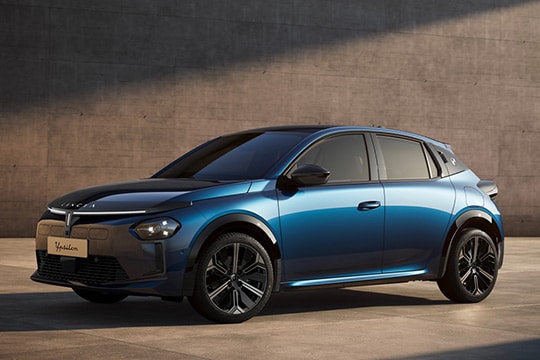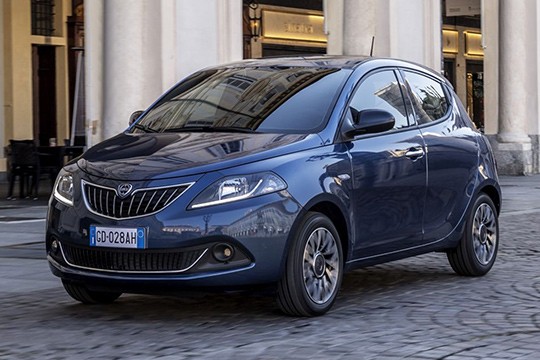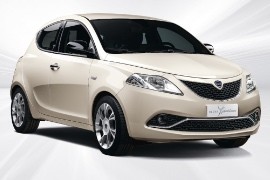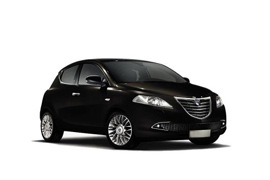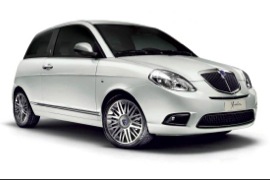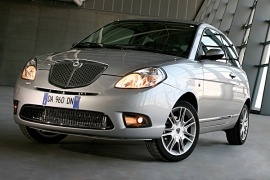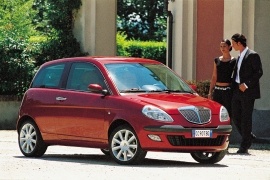LANCIA Ypsilon Models/Series Timeline, Specifications & Photos
First production year: 2003
Engines: Electric, Natural gas, Gasoline, Mild hybrid, Liquefied petroleum gas (lpg), Diesel
Body style: Hatchback
Lancia made a big comeback on the market in 2024 when it launched a fourth generation of the Ypsilon hatchback, a car that paved the way for other vehicles in the Italian automaker’s lineup.
Lancia was once a brand that thrilled customers with its high-performance cars on roads and rally stages, but some debatable decisions led this famous automaker to fall behind, ending up with one model in its stable, the third generation of the Ypsilon launched in 2011. After several updates and refreshes, the model was finally retired in 2024 to make room for a new vehicle. The new generation was built on the e-CMP2 platform developed by Stellantis for small-sized vehicles. This base could accommodate all-electric and hybrid drivetrains. It was a revolution for Lancia and a chance for a fresh start in a market where only a few premium automakers offered a small-sized vehicle. When the automaker unveiled the car in 2024, it announced it would produce a limited series of 1906 units, evoking the company’s birth year.
The car’s front fascia featured a set of horizontal and vertical LEDs for the daytime running lights. Underneath them, on the sides, the automaker placed the LED headlights, and below them, there were the vertical vents for the air curtain. On the lower bumper, Lancia installed a wide grille that was mostly blocked since the car didn’t need that much cooling area. In addition, it featured active grille shutters to enhance aerodynamics.
From its profile, the five-door hatchback was penned with rounded shapes and almost no angular lines. Lancia installed black trims around the wheel arches, creating an image of a potent vehicle. Like on the previous two generations of the Ypsilon, the car featured flush front door handles, while those for the rear ones were concealed in the C-pillars. A raked-forward tailgate nicely ended the car in a classic hot-hatch fashion, featuring round LED taillights that resembled the mighty Lancia Stratos from the late 70s.
Inside, the 2024 Ypsilon Edizione Limitata Cassina featured a modern layout with a touch of classic trims. On the center stack, the automaker installed a round element that resembled a tray, where customers could recharge their phones via an induction charger. The seats featured velvet upholstery, a material that was unusual for any car in 2024. Lancia installed a two-step dashboard that featured two 10.25-inch screens: one for the instrument panel and the other for the infotainment system. The technology was developed by Stellantis and was used on several other vehicles in the group. It supported wireless Apple CarPlay and Android Auto. In the back, the automaker installed a split-folding bench seat that could expand the trunk.
Under its skin, the fourth generation of the Ypsilon carried over the drivetrain used by the Peugeot e-208 and the e-Corsa from Opel. It featured a 156 PS (154 hp) motor that drove the front wheels and was powered by a 51 kWh (net) battery pack. With this setup, the car could travel up to 403 km (250 miles) between charges, and it could refill it from 20 to 80 percent in 24 minutes.
Instead of launching a new model, Lancia preferred to add another facelift to its aging Ypsilon model in 2021, postponing the introduction of an entirely new generation for a few years.
Once a famous brand in the rally world, Lancia was on its knees, producing one model just for the Italian market: the Ypsilon. Fiat, on the other hand, didn’t want to pull the plug on it and helped it survive. Still, it didn’t have enough money to launch a new generation for this nameplate, so it added a second refresh to keep it alive for a few more years until it was ready to replace it and introduce a successor. Still, the exterior looked similar to the vehicle introduced a decade ago, but some details made the 2021 model year stand apart. In addition, the cabin and the drivetrain were improved.
When the automaker introduced the 2015 model year, it ditched the chromed horizontal slats on it. Seven years later, though, the brand’s stylists considered re-introducing them, but this time mounted vertically, like on the third generation of the Ypsilon. In addition, a shining trim surrounded it, while the headlights sported daytime running lights that underlined them. Lower, on the apron, Lancia made a new design for the lower air intake and adorned it with a chromed stripe.
From its profile, the five-door hatchback still looked like a coupe thanks to its masked rear doors’ handles. A sculptured and ascending line decorated the vehicle’s profile that started from the front doors and ended on the rear ones. At the back, the automaker installed new taillights that had the same shape as those from the 2015 model year but with LED light stripes in them. Lancia knew its customers’ preferences, and that’s why it placed the license plate integrated into the rounded-shaped tailgate instead of placing it on the bumper. Lower, under the rear apron, the car featured a chromed and oval-shaped exhaust.
The cabin went through a more significant update. Lancia installed a new infotainment system with Android Auto and Apple CarPlay connectivity. It could be controlled via a seven-inch touchscreen placed atop the center stack above the HVAC control panel. Like on the previous model, the instrument cluster was above the dashboard, in the middle, and was filled with four dials for the speedometer, the tachometer, the fuel level, and the coolant temperature gauge, while at its bottom was a small LCD for the car’s onboard computer. Lancia also introduced new, higher-quality materials for the upholstery.
Under the hood, the most significant update was the introduction of a new mild-hybrid drivetrain that got its power from a one-liter inline-four engine paired with a six-speed manual transmission. It was assisted by an integrated belt-driven starter-generator that took its energy from a small lithium-ion battery. Still, according to Lancia, this system helped the supermini hatchback cut its emissions by 13 percent.
LANCIA Ypsilon (846) 1.3L 16V MultiJet II Start&Stop 5MT (95 HP)
After four years on the market, the Italian automaker Lancia refreshed the Ypsilon lineup, and besides exterior and interior updates, it also enhanced the drivetrain.
The fourth generation of Ypsilon saw the broad light in 2011 when cars were difficult to sell due to the world financial crisis. Still, the Italian automaker tried to offer customers an alternative for small and stylish vehicles with this lineup. It wasn’t compelling, though. But in 2015, Lancia brought the refreshed version of its smallest model to its customers at the Frankfurt Motor Show.
The automaker bragged about getting all its models up to date in terms of emission standards, which were raised to Euro 6b starting in September 2015. But there was more to brag about than just the engines.
In terms of styling, the tiny Lancia still tried to resemble the old glorious days of the brand, sporting a narrower yet wider grille above the bumper, underlined by a chromed trim. In addition, the lower bumper featured a broad air intake on the apron that could be optioned with a pair of fog lamps on its inner outer sides.
From its profile, it revealed the same coupe shape with the rear doors’ handles neatly concealed within the C-pillars and the raised waistline. The back of the vehicle showed its corner-mounted taillights that flanked the rounded-shaped tailgate adorned by a roof spoiler on the upper side. Lower, on the bumper, the automaker placed the reversing light and the rear fog lamp.
Inside, customers were greeted with new materials by the Ypsilon. Lancia also redesigned the dashboard and used new materials and techniques to build it. Atop the center stack placed the instrument cluster filled with large dials for the speedometer and tachometer and two additional gauges for the fuel level and coolant temperature.
Furthermore, a small LCD placed at the bottom of the instrument panel showed additional information coming from the car’s ECU. Lancia placed the 5” touchscreen for the infotainment system on the center stack and it used Fiat’s proprietary Uconnect system. It could connect to mobile phones via Bluetooth, a USB port, and a dedicated app, enhancing the driver’s experience and adding more music onboard the vehicle, streamed from mobile devices via the Internet.
The idea of a small, chic, luxurious vehicle was completed on the Platinum trim level, where the car spoiled its customers with leather upholstery.
Lancia offered the Ypsilon with a choice of two gasoline, one turbo diesel, and one LPG/gasoline engine. The base model was powered by an inline-four 1.2-liter naturally aspirated unit, while the second spark-ignited version was a 0.9-liter two-cylinder turbocharged unit that developed 84 PS (83 hp).
Those looking for an oil burner were rewarded with a 1.3-liter Multijet engine that provided 95 PS (94 hp) and provided a lower fuel consumption. The LPG version was mainly made for fleet use.
Despite the world financial crisis that hit the automotive industry, the Italian automaker Fiat still pushed hard on the accelerator to launch new products, including the upscale Lancia Ypsilon.
Introduced at the 2011 Geneva Motor Show, the new model was known in UK as the Chrysler Ypsilon. While the previous generation of this moniker was based on the Fiat Punto’s platform, the new model shared its underpinnings with the Fiat Panda and the Ford Ka. But, unlike its brothers, this one aimed at upscale customers who needed a supermini vehicle but didn’t like what they had to offer in terms of features and amenities. The Ypsilon, on the other hand, was a premium product thanks to its unusually rich equipment, which was fitted as standard or as an option. Fiat marketed this vehicle so it could sell it at a higher price than the Panda, so even if the sales volumes were low, it still made good money out of this model.
With a bold-looking front fascia, the third generation of the Ypsilon featured a broad, crest-like grille that was adorned by chromed horizontal slats. Its new headlights followed the new-edge design trend with rounded lines and sharp angles. Lower, on the apron, the car featured a broad air intake that helped cool the engine, and, as an option, customers could get a pair of fog lamps that flanked it. Another unique feature of the vehicle in the segment was the fact that it was available in a two-tone paint scheme, including the hood.
The most significant change in the model’s history was the fact that it was the first offered exclusively in a five-door configuration instead of three like its predecessors. But still, Lancia’s styling department made it look like it didn’t have doors in the back by concealing the handles into the rear windows’ frame. In addition, the sculptured door panels made the supermini vehicle look sporty. Finally, at the back, the quarter panels featured flared wheel arches, like shoulders, where the automaker installed the curved LED taillights that flanked the tailgate’s opening. Unlike most of its competitors in the segment, the Ypsilon was available with a panoramic glass roof.
Inside, the Ypsilon boasted an elegant cabin. The dashboard still sported a center-mounted instrument cluster and a high-mounted gear stick integrated into the center stack. Above it, the automaker placed the stereo and the HVAC control panel. Customers could get the car with cloth or leather upholstery, depending on the trim level. Besides the front bucket seats, there was a split-folding (50/50) bench seat in the back that could expand the trunk.
The third generation of the Ypsilon was available with a choice of three engines: two gasoline and one turbo diesel, ranging between 69 PS (68 hp) and 95 PS (93 hp) paired as standard with five-speed manuals. The awarded two-cylinder turbocharged engine TwinAir was also available with an automated (single clutch) gearbox.
It was the last stint for the second generation of the Ypsilon, and Lancia prepared a special edition for its supermini hatchback named Unyca.
In 2009, Europe changed its emission standards and switched to Euro 5. While most automakers used that mandatory update to launch new products or improve the ones they had, Lancia just updated the engines and called it a day. The world financial crisis was already a reality, and the Italian automaker knew it would be a waste of money. After the first years, when the Ypsilon was praised around Europe, the sales numbers plummeted, and the additional expense of creating new body panels or fancy interiors was way too risky. Moreover, it had already invested in the development of a successor for the Ypsilon. But still, before it said goodbye to the car's second generation, it prepared the Unyca as the last edition. It was the grand finale for a supermini designed especially for women.
At the front, the 2011 Unyca was available with either a chromed grille with vertical slats or a black mesh, depending on the vehicle's color. The clear-lenses headlights were the same as those from the rest of the range. In the lower side of the bumper, flanking the center air intake, Lancia installed standard fog lamps in individual clusters sporting contrasting colors.
From its profile, the Ypsilon's final edition boasted different badges on the door's frames, such as the Unyca, the Elle, or the Diva, which reflected the trim level. At the same time, the chromed Y-badge that adorned the B-post remained in place to confirm the model's nameplate. All versions sat on light alloy wheels, making the car look sporty and more appealing. In addition, the Ypsilon Unyca was available with a lower sticker that ran along the bodywork, crossing the door panels from the front fenders to the rear quarter panels. Finally, at the back, on the chromed stripe that adorned the rear bumper, the automaker placed the text "Je ne saurais vivres sans Elle," meaning "I can't live without Elle" for the highest grade.
Inside, the car boasted a luxurious cabin with velour-covered seats. Depending on the grade, the seats were covered with velour and a floral motif on the center section or contrast stitching with the Ypsilon nameplate embroidered on the headrests. The center-mounted instrument cluster featured white dials with chromed surroundings and red needles. Lancia installed a CD stereo on the center stack's upper side while the HVAC control panel was below. In the back, the split-folding (50/50) bench seat featured two headrests, a reminder that it was more of a four-seat vehicle.
Under the hood, Lancia installed a choice of three engines: a 1.2-liter gasoline, a 1.3-liter turbo diesel, and a 1.4-liter CNG powerplant. All versions were paired with five-speed manual transmissions. In addition, the Unyca was fitted with standard ESC and a softer suspension.
Just three years after the introduction of the Ypsilon’s second generation, Lancia added the first refresh for its smallest vehicle in the lineup.
The Italian automaker introduced the first refresh for the Ypsilon in late 2006. Previously, it quietly upgraded the engine lineup to comply with the Euro 4 emission standards, which became mandatory starting in January 2006. Along with the refreshed version, Lancia also introduced the ESC on the options list, a safety system that the automaker knew would become mandatory in just a few years. But still, along with these updates, the automaker also made some visual changes to the car’s exterior. As a result, customers were pleased with the new vehicles, and the automaker could keep selling the Ypsilon and help the struggling Italian brand survive.
Sometimes, the differences between a facelifted and a non-facelifted vehicle are so thin that you need a keen eye for detail. Fortunately for Lancia, this wasn’t the case. The 2006 Ypsilon featured a redesigned grille that sported an increased number of vertical slats on it and redesigned headlights with clear lenses. In addition, the lower bumper was completely new and featured an A-shaped lower grille flanked by a pair of scoops for the available fog lamps.
From its profile, the 2006 Ypsilon gained a new decoration on the B-post, with a chromed Y-shaped logo from the car’s nameplate. The car also became available in new colors, and Lancia offered it in five grades. Still, the base trims were provided with steel wheels and caps, and only the upper grades, such as the Yellow Gold and the Platinum, were fitted with standard alloys. Finally, at the back, the automaker installed new clear-lenses taillights that replaced the previously used ones, which were red from top to bottom. Last but not least, while the rear bumper was new. It sported a chromed horizontal slat ending with red trims on its outer sides. Last but not least, the car was no longer available with black rubber stripes to protect the paint against minor scratches in the parking lot.
Inside the cabin, the automaker didn’t feel it had to improve the vehicle too much. While other automakers had to give up on their intentions to install center-mounted instrument clusters due to customers’ demands, Lancia did not. Moreover, it also kept the same high-mounted gear stick on the center console. Still, the automaker considered offering a new infotainment unit named Blue&Me featuring Bluetooth connectivity and USB for MP3 players and iPods. At the back, customers could get the car with a split-folding (50/50) bench seat to expand the trunk space.
Under the hood, the automaker offered the car with a choice of gasoline and turbo diesel powerplants mated with five- or six-speed manual transmissions. Lancia also installed a five-speed automated (single-clutch) gearbox for selected engine versions.
The Italian automaker Lancia introduced the second generation of the Ypsilon in 2003 and built it on the same platform as the Fiat Punto, a mundane vehicle made for the masses.
While most supermini hatchbacks looked similar, the Ypsilon dared to be different. Even if it shared its underpinnings with the Punto, it was a different car, not just a badge-engineered vehicle. Its design was fresh, the materials used for the interior were more upscale, and it was promoted as a fancy little car built to be driven mostly in crowded cities. Thanks to its size, it was easier to park than most premium vehicles. Fiat and Lancia knew these advantages from the car’s first generation, which was introduced in 1995. So, when it launched the second generation of this nameplate, it used the lessons learned from the car’s predecessor. It quickly became the best-selling Lancia, with over 60,000 units a year. This unexpected success forced the automaker to relocate the production facility.
With a design inspired by the 1939 Lancia Ardea, the 2003 Ypsilon featured a crest-like grille in the middle of the front fascia. Its organic-shaped headlights were swept back on the front fenders, while below the bumper, customers could get a set of round fog lamps to flank the additional lower air intake. To lower repair costs of the bumper, the automaker adorned it with a wide rubber stripe.
From its profile, the three-door hatchback had a different aspect than the Punto. First of all, it had a shorter wheelbase since Lancia didn’t want the Ypsilon to have five doors. It was mainly built for those seated in the front seats. The design team penned the vehicle with a tall greenhouse compared to the rest of the car. Unlike its Fiat sibling, it also sported sculptured lines on the sides that ran from the front fenders along the door panels towards the rear quarter panels. Finally, the Ypsilon featured slim, oblique taillights at the back that flanked the tailgate, and the rear bumper also sported a horizontal rubber stripe for the same reason as the one from the front.
Inside, the automaker created a unique cabin fitted with a center-mounted instrument cluster atop the dashboard that sported large dials for the speedometer and tachometer and a third small gauge between them for the fuel level. In addition, a small screen at the bottom of the instrument panel displayed the odometer. Unlike most other vehicles from this segment, the Ypsilon had leather seats and an infotainment system that could be accessed via a dedicated app. The high-mounted seats and the pedals designed specifically to allow driving with high heels were also a particular feature of the car. In the back, there was hardly room for two children, but it served very well as an in-car luggage shelf.
Under the hood, the second generation of the Ypsilon came with a choice of gasoline and diesel engines ranging between 60 PS (59 hp) and 80 PS (78 hp). They were all paired with a five-speed manual as standard, while an automated (single-clutch) gearbox was available.
